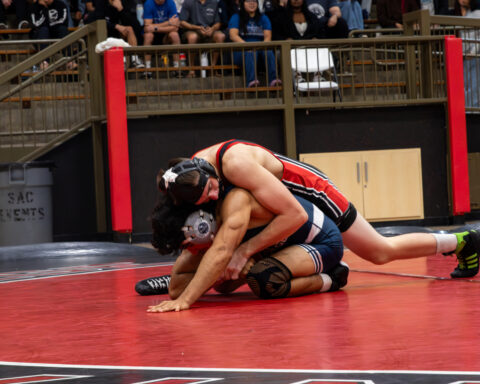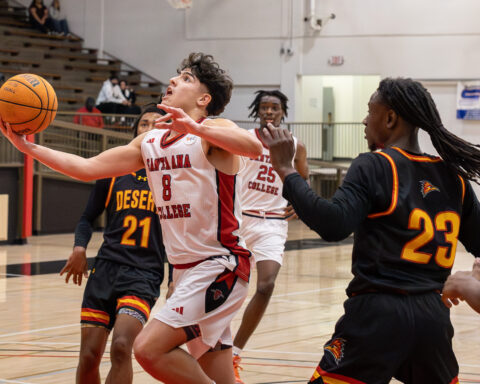I watch closely as 77-year-old Santa Ana College alumnus Barry Asher begins his routine.
It’s his first time picking up a bowling ball in six months. As he shuffles his feet, getting a hold of the hardwood floor, Barry blows a puff of air into the ball for grip.
I had never seen this before, but hey, he’s the one in the Pro Bowling Hall of Fame. He relaxes his shoulders before stepping forward and sending his ball sliding down the glossy lane.
Barry perfectly places the ball in the pocket between the headpin and the 3-pin, sending all 10 tumbling quicker than you can say turkey.

I watch in awe as he destroys me effortlessly; even at his age he has got a lead of about 100 points, but it feels like more. It reminds me of his 1976 Tucson Open when Barry faced Dave Soutar in the championship and blew him out 265-164. Now I know how Soutar felt.
When we walk back to the Champions pro shop, the store he runs inside the Fountain Bowl, he is greeted by plenty of familiar faces. Striking up conversations with bowlers and giving out fist bumps to anyone who will take them.
As he leads me into his shop, I notice the walls are lined with bowling balls waiting to be picked out by customers for Barry to drill, clean, and fit to their exact specifications.
Along with shoes, bags, and cleaning supplies, his shop has everything people need.

Barry offers me a seat, an older wooden chair with a little bit of padding as I ask him about his first experience with the sport.
“The first time I ever went bowling was for a kid’s birthday party,” said Asher. “I had gotten the ‘booby prize’ for last. Just awful.” Growing up in the LA suburbs, Barry wanted to find his “groove.”
“I wasn’t good enough at baseball, I couldn’t really hit or pitch, and I wasn’t big enough for football,” he said. “But the more I bowled the more I realized how much I actually liked it.”
Bowling turned out to be the answer for him.
He told me the story of when his father gave him a bowling ball for Christmas one year and
Barry would go to the lanes every day after school. At age 10 he was already averaging 170, almost unheard of at the time.
His story gets interrupted as he tends to a customer. He clambers out of his chair and helps the customer, cracking jokes and smiling in every interaction. He rings him up before getting back to the interview.
“One day I was approached by Esther Woods, a bowling instructor,” said Asher. “Esther would go around the country giving clinics and giving exhibitions. She started giving me some lessons and taking me when she would do her jobs.”
Perhaps this investment from Woods later on inspired Barry, who now runs camps and programs teaching people to bowl.
At 15. Barry went on a group trip to San Francisco for a tournament. As the youngest player with the highest average, he was approached by a woman organizing the event who asked if Barry would like to participate in an upcoming Pro-Am, a mixed tournament for professionals and amateurs. To her surprise. Barry said no.
“I don’t want to bowl in the Pro-Am,” he said. “I want to bowl in the pro tournament.”
This act of courage was rewarded and after a few calls, Barry had secured a spot in his first-ever pro tournament.
As he looked back at this milestone, I couldn’t help but notice a smile on his face. He was experiencing this moment all over again.
“I ended up bowling with Don Carter who was the greatest bowler of the time, the first athlete with a million-dollar contract,” said Asher. “I went into the locker room and bowling came to life in front of my 15-year-old eyes. All these guys I’d seen on TV and they’re standing around in their sports coats talking and I’m just sitting there thinking, ‘Wow, man, this is what I want to do.”
After his first taste of the pro leagues, Barry was hooked. He played in four more pro tournaments before he officially became a member at age 18.

That summer, with the ‘60s in full swing, he toured with the pros. He won cash prizes a couple of times, but he also gained valuable experience.
After the tour, he returned to OC with his family and enrolled in a couple of classes at Santa Ana College. However, the lanes still called his name. He wasn’t very interested in school, rushing back to the now-defunct Santa Ana Lanes the second his classes ended.
He looked at me and said how he wished he took school more seriously, but deep down Barry knew he had to be a bowler.
He had hit a wall in his game and was struggling to remain consistent.
Barry was bowling late one night when the manager of the lanes, Don Hooper, approached Barry claiming he could help him if he came back tomorrow. Barry reasoned, “It’s only midnight, why not now?”
Hooper and Barry ended up staying at the lanes, practicing Barry’s approach and throw until 4 a.m.
Hooper’s assistance couldn’t have come at a more perfect time as the next pro tournament event took place in Encino, Barry’s hometown.
He looked back into the moment with a bit of a smirk and a gleam in his eye; he knew he was the underdog, and he knew how the story ended.
“Coming into it, nobody expected me to win,” said Asher. “I was some big-mouthed teenager telling everyone who I was going to be.”
Barry won the Encino tournament, earning himself his first-ever PBA title.
“After that, I didn’t have to tell anybody who I was gonna be anymore. I shut up and let my game speak for itself.”
Barry spent the next summer much like the last: touring with the seasoned pros, earning a little bit of money and building his skills. When fall rolled around, he was surprised to see not school enrollment forms, but a draft notice on his table.
Barry was one of the over 2 million American men drafted during the Vietnam War. In 1968 he had to report to basic training, making him drop out of school while temporarily derailing his bowling career, and life, in the process.
“When I finally got out [of service], it was a struggle. I didn’t really get back into stride until two years later in 1971.”
But when he finally got back into his rhythm, he was on fire, winning six PBA titles from 1971-73 and catching the bowling world by storm.
At his peak, it wasn’t just his dominance, but his fashion sense that drew attention. Announcers would often refer to him as the “The Most Fashionable Man in Bowling.” Watching the broadcasts of Barry in the ‘70s explains it: the striped blue polos, tight bell bottoms, illustrious curly hair.
Today, Barry opts for a basic T-shirt and jeans. He wears a beanie because his head gets cold. It’s not just the simpler outfit, his entire persona is much quieter now. When I first entered the Fountain Bowl, I walked right past him. It’s easy to imagine that most people do: who would ever assume that this man in the bowling shop is a sports legend?
In ‘75 he won his ninth title and in ‘76’s dominant performance against Soutar, he had eclipsed the double-digit mark, but on the way home from Tucson was filled with retirement thoughts.
“That night, I’m going ‘Man, I’m not sure if I want to do this much longer! I had already accomplished so much, and my head wasn’t in it anymore, I struggled to even finish an event.”
Some may think this an anticlimactic end to Barry’s reign over the sport, but it seems like it’s exactly what he wanted.

He would retire and earn a spot in the PBA Hall of Fame in 1988. He was selected as one of the Top 50 Greatest Bowlers of All Time in 2008. He would also be hired as the bowling coordinator for The Big Lebowski, throwing every ball in the movie. “Now at my age, I realize it’s not about the titles or the accolades,” he reminisced.
“The most important thing to me was all the connections I made, the lifelong friends I still have to this day.” His love for the sport has kept him around the lanes and the bowling legend sees no end in sight.
“Why retire?” he says, chuckling. “I can’t picture myself having any more fun doing anything but this.”















Barry is a great person as well!
Nice article, but it doesn’t cover the class of Asher. He rates right up there with Mike McGrath, Don Johnson, Dick Weber and a few of the other top bowlers. It also didn’t cover the competitive nature of Barry. But I guess that would have taken numerous pages and more space than allotted. Thanks.
A great story of one of the early stars of the PBA. I met him years ago in Las Vegas, and chatted for a while. A real nice, down to earth individual.